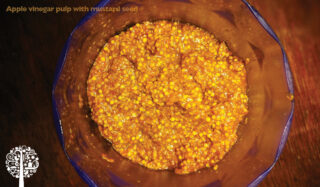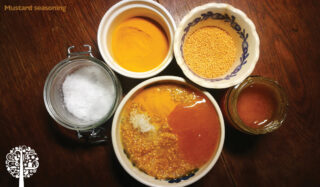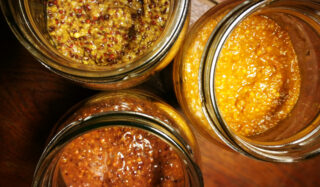The western world and its attitudes have changed significantly over the last decade. More humans than ever pay attention to what we feed ourselves, how we grow our food, what we put on our skin, and the waste we produce. The healthy eating boom has no end, with more of us checking out old cookbooks and grandma’s herbal remedies. Some of this information may be outdated and challenging (I don’t know how you feel about leeches purifying blood, but I’m not convinced yet). Still, there is undoubtedly a wealth of knowledge that we should not forget. Many herbs and common weeds have powers that effectively fight health issues like colds, and eczema, or even repelling nasty bugs. In our kitchens, people are swapping ready-made products for experimentation with homemade ones, often realising that they are far superior to the mass-produced items on the market. I have embarked upon several of these adventures in the last year, producing some of my first fermented foods, vinegar, teas and skin products. Some of these mad scientist games have resulted in weird and wonderful concoctions; others I likely won’t bother making again. Overall, the learning curve has been so much fun, and I think you should try making some of them.

Mustard
The ultimate ‘secret ingredient’ in many barbecue sauce recipes and the best companion for a Polish grilled sausage (in my slightly biased opinion), mustard is a condiment known in thousands of forms across the globe. If you’ve already caught the vinegar-making bug (see past editions), you can follow the zero-waste trend and use leftovers to make delicious mustard. After straining the liquid into the bottles, you’ll be left with fruit or veg pulp, making an excellent mustard base. The ingredients are approximate, and you’re better off trusting your eyes and taste buds for seasoning; we all prefer different spice levels. The main components are fruit pulp and mustard seeds, and the heat of the final product will depend on their colour. For instance, yellow mustard seeds are milder; black ones are hotter.

Start by blending the pulp into a smooth mass – this may not be needed when you use soft fruit like pineapple or blackberries, but the apples need a good whizz. Next, add the mustard seeds of your choice, roughly in a ratio of pulp to seeds 2:1, and leave for a day to soak. Be sure you leave enough room in your jar as the contents will double in mass.
Add salt and honey to taste the next day and some turmeric to create a beautiful yellow colour. Mix well and leave in the fridge for another 24 hours. On day three, blend everything into a smooth mass again, and season if desired – the mustard will be very hot right now, but don’t worry about it, make sure that the sweetness and saltiness are to your taste. If the texture seems too thick, add a splash of vinegar or olive oil. Pack it tightly into a clean jar without air bubbles. The mustard is almost ready; it only needs around six weeks in the fridge or a cold cellar to mature! After this time, the heat will be milder, and all the ingredients will combine and create a unique flavour. As an unknown author from Dijon would have said, voila!
Oxymel
Winter months are often harsh to our bodies, with cold, damp weather and a distinct lack of fresh, nutritious food. Oxymel is an ancient tonic that is a must-have in my household. The name consists of oxy, meaning acid, and mel, meaning honey. So oxymel is a mixture of 1:1 or 1:2 apple vinegar and honey. It sounds pungent, and if you have never had the pleasure of trying one, it’s a hell of an experience. You can enhance the apple vinegar with herbs of your choice. Doing so will add to the flavour and boost the mixture’s healing properties. Depending on your aim, you could try macerating (steeping in liquid for about four weeks) elderberries in vinegar. This option results in an excellent cold-preventing oxymel. Adding thyme, rosemary, and cloves to the vinegar soak creates an oxymel that supports the respiratory system (thyme is perfect for nasty coughs). These mixtures are primarily used in wintertime when we need this extra boost and virus protection. However, the time to collect, dry, and store those precious herbs is throughout the summer, so it’s worth planning your forage.
Fire Cider
This one is not for the faint of heart! Fire Cider, as the name says, is guaranteed to cause some challenging feelings in your mouth, but it is known to be a reliable immune-boosting drink, helping to prevent and treat colds and aiding digestion. Drink it by the teaspoonful in some tea or water, and even this is a rather sensational experience. You can add it to soups and stews for some extra heat and mineral absorption (as vinegar helps break amino acids from bones if you’re a meat eater). The original recipe from the 1970s includes fresh garlic, fresh ginger, horseradish, onions and cayenne pepper. Nowadays, fresh turmeric root, lemons, oranges, star anise and cloves are added. All those plants contain many vitamins and minerals extracted by the vinegar maceration, leaving us with a drink that no bacteria or viruses want to face.
Bug spray
Many herbs are excellent for your health, but the difference between a medicine and a poison is the dose. Some are considered toxic, even in small quantities. Tanacetum vulgare, or Tansy, if we were to go by its common name, is one that even experienced herbalists will use with caution and only externally. It is, however, one of the best remedies for all sorts of nasty biting insects, thanks to a compound it contains – thujone. Tansy vinegar will destroy all skin parasites such as lice, fleas, fungal infections, Demodex mites, and scabies. When sprayed on clothing, it will deter ticks, mosquitoes, and midges, making your camping holiday fun again. You could either make such vinegar from scratch or macerate tansy flowers in a ready-made one. This simple remedy is beneficial in woodland areas where ticks hang out or for a regular debugging of pet bedding. And if you happen to have a bad fall and end up covered in bruises, the same vinegar applied to the skin will speed up the healing process, fade the bruises away, and help reduce swelling.

Curiosity and a willingness to learn about plants have always been a great advantage to humans. Repelling, attracting, and healing properties have been discovered over the centuries (although presumably with a generous handful of casualties left behind). Today, we have the knowledge left by our ancestors, coupled with a better understanding of the processes and chemical composition of plants. These tools should empower us to look around, wonder, and carefully try some of the mixtures ourselves. Not advisable for cats, though; apparently, curiosity kills the poor buggers.
Disclaimer: Whenever experimenting with plants for consumption, do extensive research so you know the final product is safe!
very informative articles or reviews at this time.